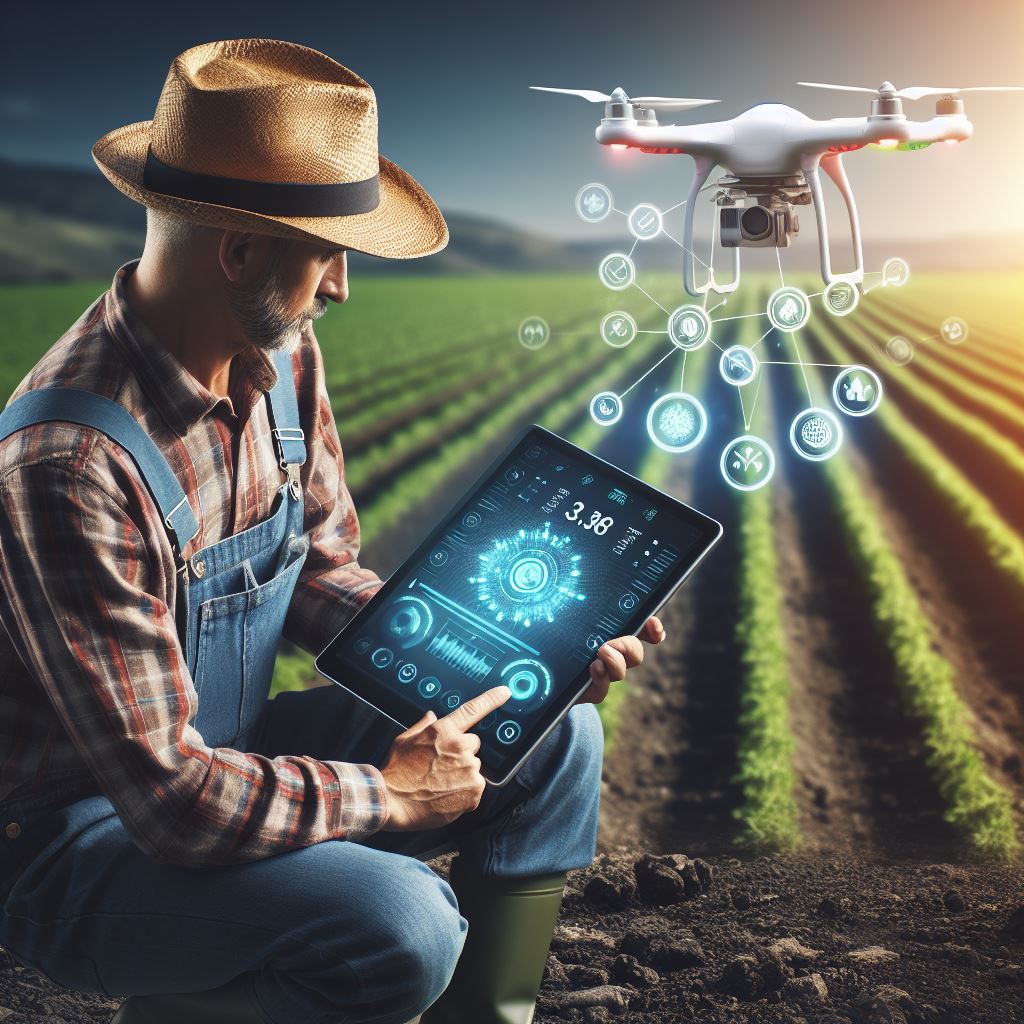Introduction
As I gazed at the lush, greenery thriving without soil in a hydroponic system, I was captivated.
Hydroponics is a method of growing plants without soil, using a nutrient-rich water solution.
In this blog section, I will share my journey into hydroponics and explore its vast potential for future farming.
My curiosity led me to embark on a hydroponic venture, seeking innovative farming practices.
With hydroponics, plants receive all necessary nutrients directly in their water-based root systems.
By eliminating the need for soil, hydroponics promises higher yields, reduced resources, and year-round cultivation.
Setting up my hydroponic system was both challenging and exciting, filled with experimentation.
I carefully balanced the nutrient solution and adjusted lighting and temperature for optimal plant growth.
Despite initial setbacks, I observed my plants thrive and develop faster than traditional soil-based farming.
The potential of hydroponics in future farming is vast, addressing global challenges of food security.
With hydroponics, crops can be grown in arid regions, reducing dependence on fertile land.
Moreover, hydroponic systems can be tailored to maximize efficiency and minimize water usage.
Hydroponics also offers the opportunity for urban farming, utilizing vertical spaces and rooftops.
By bringing agriculture closer to urban centers, food transportation distances and carbon emissions can be significantly reduced.
This sustainable approach has the potential to revolutionize our food production systems for a greener future.
In fact, my venture into hydroponics has demonstrated its potential as a transformative farming technique.
With higher yields, resource efficiency, and the ability to overcome geographical limitations, hydroponics offers hope for future food production.
I am excited to continue my journey and contribute to the advancement of this innovative farming practice.
The Basics of Hydroponics
Definition and explanation of hydroponics
Hydroponics is a method of growing plants without soil, where nutrient-rich water is used to provide sustenance.
This innovative technique allows plants to grow in a controlled environment.
Different types of hydroponic systems
- Nutrient Film Technique (NFT): This system relies on a thin film of nutrient-rich water flowing past the roots, providing the plants with the necessary nutrients.
- Deep Water Culture (DWC): In this system, the roots are submerged directly into a nutrient solution, ensuring constant access to essential elements for growth.
- Aeroponics: By misting the roots with a nutrient solution, aeroponics allows maximal oxygenation, promoting rapid plant development.
- Drip System: This popular hydroponic method involves using a timer to deliver nutrients to the plant roots via drippers, creating a highly efficient growing system.
Benefits of hydroponics compared to traditional farming methods
- Water conservation: Hydroponics requires up to 90% less water compared to traditional soil farming, making it a sustainable choice for agriculture.
- Space efficiency: By eliminating the need for soil, hydroponic systems can be set up vertically, maximizing the use of available space and allowing for higher plant density.
- Faster growth: With precise control over nutrients and environmental conditions, hydroponic plants grow up to 50% faster than their soil-grown counterparts.
- Year-round cultivation: Hydroponics allows for year-round cultivation and eliminates the limitation of seasonal changes, ensuring a constant supply of fresh produce.
- Fewer pests and diseases: Without soil, hydroponic systems inherently reduce the risk of soil-borne pathogens and pests, minimizing the need for pesticides.
- Nutrient control: Hydroponics offers unparalleled control over the nutrient content, enabling optimization of plant growth and crop quality.
- Sustainable farming: As hydroponics eliminates the need for synthetic fertilizers, reduces water usage, and mitigates soil erosion, it represents an environmentally friendly farming method.
- Higher yields: Due to the optimized growing conditions, hydroponics can result in higher crop yields per square meter compared to traditional farming.
- Consistent quality: With controlled factors such as lighting, temperature, and pH levels, hydroponics ensures consistent produce quality and flavor.
- Urban farming potential: The compact nature of hydroponics makes it suitable for urban areas, enabling communities to cultivate fresh produce locally.
In short, hydroponics offers a sustainable and efficient alternative to traditional farming methods.
By eliminating soil, optimizing nutrient delivery, and controlling environmental variables, this technique allows for year-round cultivation, maximized space utilization, and increased crop yields.
With benefits ranging from water conservation to pest reduction, hydroponics represents a promising solution for the future of agriculture.
My Journey into Hydroponics
Why I decided to try hydroponics
- I became interested in hydroponics after realizing the potential to grow plants without soil.
- The idea of sustainable farming and conserving water resources intrigued me.
- I wanted to explore the possibility of growing fresh produce in my own home.
Initial challenges and learning curve
- Setting up my hydroponic system was a daunting task, especially as a beginner.
- I had to learn about different types of hydroponic systems and choose the one that suited my needs.
- Understanding the proper nutrient balance and pH levels for plants was a learning curve that required patience.
Importance of research and planning before starting
- Researching various hydroponic techniques helped me understand the basics and potential problems.
- Planning ahead allowed me to anticipate and overcome potential challenges in my hydroponic journey.
- Knowledge of plant nutrients and their requirements was crucial for successful hydroponic cultivation.
Benefits and rewards of hydroponics
- Hydroponics offers a space-saving solution, making it ideal for urban dwellers like myself.
- The controlled environment of hydroponics eliminates the use of pesticides and other harmful chemicals.
- Growing plants in a nutrient-rich solution ensures faster growth and higher yields compared to traditional farming.
Hydroponics: a sustainable farming method
- Hydroponics reduces water consumption by up to 90%, making it a more sustainable farming method.
- The absence of soil reduces the risk of soil-borne diseases, improving plant health and yield.
- Urban hydroponic farming can significantly reduce the carbon footprint associated with transportation of produce.
Overcoming common challenges in hydroponics
- Maintaining proper pH levels and nutrient balance was crucial for plant health and growth.
- Controlling temperature, humidity, and ventilation in the growing area was essential for preventing fungal diseases.
- Regular monitoring and adjusting of the hydroponic system helped prevent nutrient deficiencies or excesses.
Expanding my hydroponic setup
- As I gained experience and confidence, I expanded my hydroponic setup to grow a wider variety of plants.
- Experimenting with different types of hydroponic systems allowed me to understand their strengths and limitations.
- Growing herbs, lettuce, and even strawberries became possible within the comfort of my own home.
Sharing my knowledge and inspiring others
- I started sharing my hydroponics journey on social media platforms to inspire others to try this innovative farming method.
- Providing useful tips and answering questions from fellow hydroponic enthusiasts allowed me to foster a sense of community.
- Witnessing others’ success stories in hydroponics motivated me to continue pushing the boundaries in my own venture.
In essence, my journey into hydroponics has been a fulfilling and educational experience.
The decision to explore this sustainable farming method has opened up a whole new world of possibilities.
Despite the initial challenges and learning curve, the benefits of hydroponics, both for the environment and personal satisfaction, have been rewarding.
Through research, planning, and continuous learning, I have been able to overcome common obstacles and expand my hydroponic setup.
By sharing my knowledge and inspiring others, I hope to contribute to the growth of hydroponics as a viable and sustainable agricultural practice.
Read: Labor Shortages: A Farmer’s Dilemma
Setting Up a Hydroponic Farm
Selecting an Appropriate Location
Setting up a hydroponic farm requires careful consideration of several key aspects.
Firstly, selecting an appropriate location is crucial to ensure optimal plant growth and productivity.
It is essential to identify a location that receives ample sunlight and has easy access to water sources.
Additionally, the size of the area should be suitable to accommodate the hydroponic system and potential expansion in the future.
Furthermore, ensuring the location is secure and protected from external factors like pests or extreme weather conditions is essential to safeguard the crops.
Choosing the Right Hydroponic System for My Needs
Choosing the right hydroponic system is another critical factor in setting up a successful farm.
There are various types of hydroponic systems available, such as nutrient film technique, deep water culture, or aeroponics.
Each system has its advantages and disadvantages in terms of space requirements, cost, and maintenance.
Evaluating the specific needs of the crops or plants intended to be grown will help in selecting the most suitable system.
Additionally, considering the level of automation and control offered by each system can streamline operations and maximize efficiency.
Acquiring Necessary Equipment and Supplies
Once the hydroponic system is chosen, acquiring the necessary equipment and supplies is the next step.
It is essential to create a comprehensive list of all required items, including containers, growing medium, lighting systems, pumps, timers, pH meters, and nutrients.
Researching reliable suppliers and comparing prices can help in making cost-effective purchasing decisions.
Moreover, considering the quality and durability of the equipment is vital to avoid frequent replacements that can add unnecessary expenses.
Allocating a budget for acquiring all necessary equipment and supplies ensures a smooth setup process.
Overall, setting up a hydroponic farm involves careful planning and decision-making.
Selecting the right location, choosing an appropriate hydroponic system, and acquiring necessary equipment and supplies are essential steps to establish a successful venture in hydroponics.
By paying attention to these aspects, I can ensure a solid foundation for my future in sustainable farming.
Read: Sustainable Practices: A Farmer’s Journey
The Hydroponic Growing Process
In my previous section, I discussed the benefits of hydroponic farming and my decision to venture into this innovative method of growing plants.
Now, let’s dive into the hydroponic growing process and explore the steps involved:
Seeds and Seedlings Selection
Implementing the hydroponic growing process requires meticulous attention to detail and regular monitoring.
Each step plays a crucial role in the success of your farm, so focus on continuous learning and improvement.
Once you have selected the right seeds and seedlings, it’s time to move on to creating and maintaining nutrient solutions.
These solutions are the lifeline of your hydroponic system, providing plants with the necessary minerals and elements for growth.
Nutrient Solutions and Water Management
Monitoring pH levels is essential to ensure optimal nutrient absorption.
Regularly check and adjust the pH level to keep it within the recommended range for your chosen crops.
Water management is another critical aspect of hydroponic farming.
Preventing water stagnation is crucial to avoid root rot and diseases.
Use systems that allow for proper drainage and recycling of water to maintain a healthy growing environment.
Transform Your Agribusiness
Unlock your farm's potential with expert advice tailored to your needs. Get actionable steps that drive real results.
Get StartedManaging Light and Temperature for Optimal Plant Growth
Proper lighting is vital for the photosynthesis process in hydroponic farms.
High-quality grow lights that emit the correct light spectrum should be selected for different growth stages.
Invest in timers to maintain consistent light cycles for your plants.
This will ensure they receive the right amount of light at the right time.
Temperature control is crucial to prevent any heat or cold-related stress on your plants.
Different crops have specific temperature requirements, so ensure you are aware of their optimal ranges.
Effective ventilation systems are necessary to maintain proper airflow and prevent temperature fluctuations.
This will contribute to creating the ideal growing conditions for your plants.
In the next section, I will discuss the importance of crop maintenance and pest control in hydroponic farming. Stay tuned!
Read: Vertical Farming: Highs and Lows

Overcoming Obstacles in Hydroponics
Dealing with pests and diseases without using pesticides
Overcoming obstacles in hydroponics requires vigilance, knowledge, and a proactive approach.
By implementing integrated pest management strategies, one can control pests and diseases without the need for harmful pesticides.
Introducing beneficial insects, using physical barriers, and applying organic insecticides sparingly can help maintain a pest-free environment.
Monitoring and adjusting nutrient levels
Monitoring and adjusting nutrient levels is crucial for ensuring optimal plant growth.
By utilizing sensors, software, and regular testing, one can maintain the ideal nutrient balance.
It is essential to understand specific nutrient requirements and promptly address any deficiencies or toxicities.
Preventing waterborne pathogens and algae growth in the system
Preventing waterborne pathogens and algae growth is another challenge in hydroponics.
Proper water sterilization, following strict hygiene protocols, and utilizing quality water filters can help mitigate these issues.
Additionally, installing light-excluding covers and monitoring water quality regularly can prevent algae growth and potential pathogens.
With dedication and a thorough understanding of these challenges, one can overcome obstacles in hydroponics and enjoy the numerous benefits it offers.
By promoting sustainable farming practices and maximizing crop yields, hydroponics can play a crucial role in shaping the future of farming.
Read: Rooftop Farm Magic: An NYC Urban Farmer’s Tale
Maximizing Yield and Efficiency
Achieving maximum yield and efficiency in hydroponic farming requires implementing various techniques and utilizing automation and technology.
This section explores the importance of proper plant spacing and pruning, managing plant growth stages, and utilizing automation for better productivity.
Implementing proper plant spacing and pruning techniques
- Plant spacing plays a crucial role in maximizing yield and preventing overcrowding in hydroponic systems.
- By providing adequate space between plants, each plant receives sufficient light, water, and nutrients for optimal growth.
- Regular pruning helps maintain the desired size and shape of the plants, improving airflow and light penetration.
- Pruning also removes diseased or damaged plant parts, reducing the risk of spreading infections.
- Proper pruning techniques include removing lower leaves, cutting off excessive growth, and training plants to grow upward.
Managing plant growth stages and harvesting
- Monitoring plant growth stages is crucial for managing the timing of nutrient application and adjusting environmental conditions.
- Understanding the specific needs of each growth stage allows farmers to optimize resource allocation and encourage healthy growth.
- Harvesting at the right time ensures optimum quality and flavor of the produce, maximizing market value.
- Regularly monitoring plant growth and identifying maturity indicators help determine the ideal harvest time.
- Harvesting techniques should focus on minimizing damage to the plants and ensuring proper post-harvest handling for longer shelf life.
Utilizing automation and technology for better productivity
- Automation systems, such as timers, sensors, and climate control devices, enable precise control of environmental factors.
- Automated nutrient delivery systems ensure accurate and consistent nutrient supply, optimizing plant growth.
- Technology-driven monitoring systems provide real-time data on temperature, humidity, pH levels, and nutrient concentration.
- Data analysis and remote monitoring enable farmers to make timely adjustments and optimize resource utilization.
- Incorporating advanced technologies like AI-based algorithms and robotics can further enhance efficiency and reduce labor requirements.
In review, maximizing yield and efficiency in hydroponic farming relies on implementing proper plant spacing and pruning techniques, managing plant growth stages, and utilizing automation and technology.
By optimizing these factors, farmers can achieve higher productivity, better quality produce, and more sustainable farming practices. Embracing innovation in hydroponics paves the way for a promising future in agriculture.
Benefits and Potential of Hydroponics
In my previous sections, I have shared my journey into hydroponics and the reasons why I decided to embark on this venture.
Now, let’s delve into the benefits and potential that hydroponics offers.
Greater control over plant growth and quality
- With hydroponics, I have the ability to control various factors that influence plant growth, such as nutrient balance, pH level, and light exposure.
- This control allows me to optimize conditions for each plant, ensuring they get exactly what they need to thrive.
- As a result, I have noticed significant improvements in the overall quality of my plants, including better taste, texture, and nutritional value.
- Hydroponics also minimizes the risk of pests and diseases, as the controlled environment reduces the chances of infestations.
Higher yields and faster harvest cycles
- One of the most exciting benefits of hydroponics is the ability to achieve higher yields compared to traditional farming methods.
- The optimized conditions and increased nutrient availability lead to faster and more productive growth.
- I have witnessed firsthand how my hydroponic plants grow at an accelerated rate, allowing for multiple harvests in a shorter span of time.
- This increased efficiency not only benefits me as a farmer but also contributes to the overall food production and availability.
Reduced water usage and environmental impact
- Water scarcity is a growing concern in today’s world, and hydroponics offers a solution to this problem.
- Compared to traditional soil-based farming, hydroponics uses significantly less water.
- The water used in hydroponic systems is recirculated, meaning it can be reused and conserved.
- This not only helps in reducing water consumption but also minimizes the environmental impact associated with agriculture.
- In addition, hydroponics eliminates the need for harmful pesticides and herbicides, making it a sustainable and eco-friendly farming method.
In general, hydroponics brings numerous benefits and potentials that are transforming the future of farming.
With greater control over plant growth and quality, higher yields, faster harvest cycles, reduced water usage, and environmental impact, it is a game-changer in the agricultural industry.
Through my venture into hydroponics, I have experienced the advantages firsthand and firmly believe in its potential to revolutionize food production.
Whether you are a small-scale farmer or a backyard enthusiast, exploring hydroponics can lead to a thriving and sustainable farming future.
Conclusion
Recap of hydroponics benefits and my journey
Throughout my venture into hydroponics, I have experienced numerous benefits that have truly impressed me.
The ability to grow plants without soil, using only water enriched with nutrients, has not only increased the yield but also eliminated the need for harmful pesticides.
I have witnessed firsthand how hydroponics can be a sustainable way of farming, conserving water and maximizing space utilization.
The controlled environment of hydroponic systems has allowed me to grow crops all year round, regardless of the weather conditions.
Encouragement for others interested in hydroponics
If you are interested in hydroponics, I highly encourage you to dive in and give it a try.
The learning process might seem challenging at first, but the rewards are definitely worth it.
Hydroponics provides an opportunity to cultivate fresh, pesticide-free produce efficiently and economically.
There are various resources available, from online tutorials to local communities, that can provide guidance and support in your hydroponic journey.
Don’t be afraid to experiment and adapt different techniques to suit your specific needs and crops.
Final thoughts on the future of hydroponics in modern farming
As we move towards a more sustainable and efficient future in agriculture, hydroponics will undoubtedly play a significant role.
Its ability to produce higher yields using less water and space makes it an ideal solution for urban farming and areas with limited arable land.
With advancements in technology, the future of hydroponics looks promising.
Innovations such as vertical farming and automated systems will further enhance the scalability and productivity of these techniques.
Undoubtedly, hydroponics is revolutionizing the farming industry and has the potential to address various challenges faced by traditional farming methods.
Embracing hydroponics opens doors to a greener and more prosperous future for agriculture.




